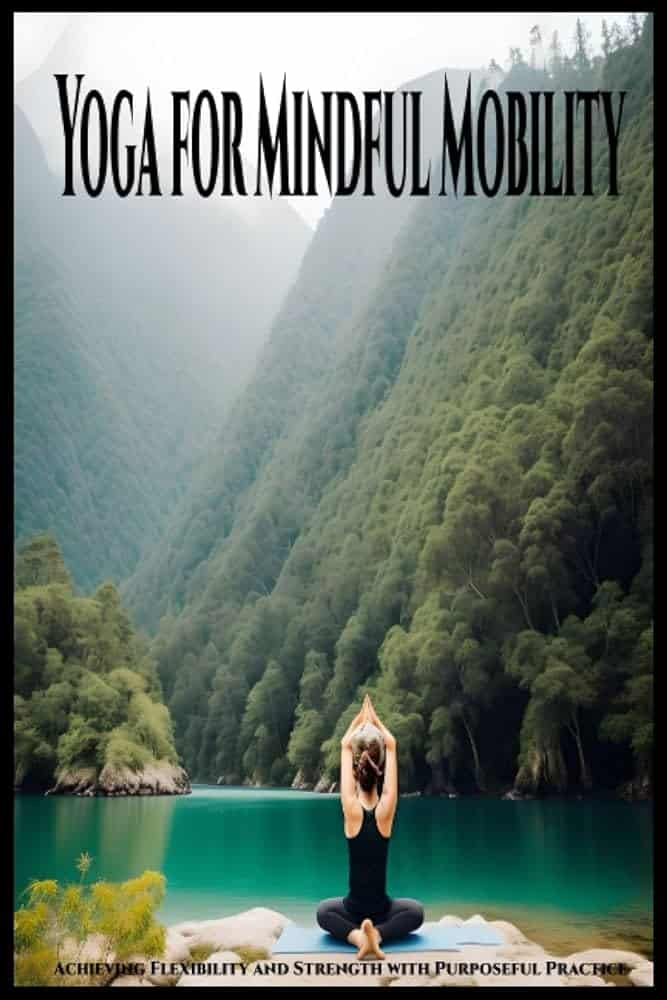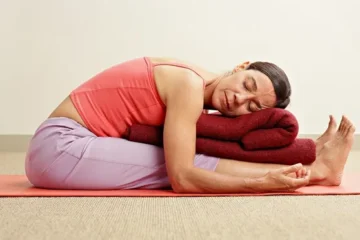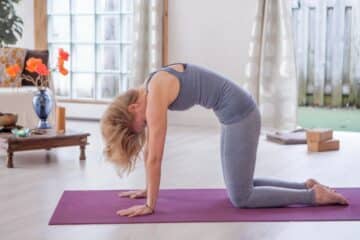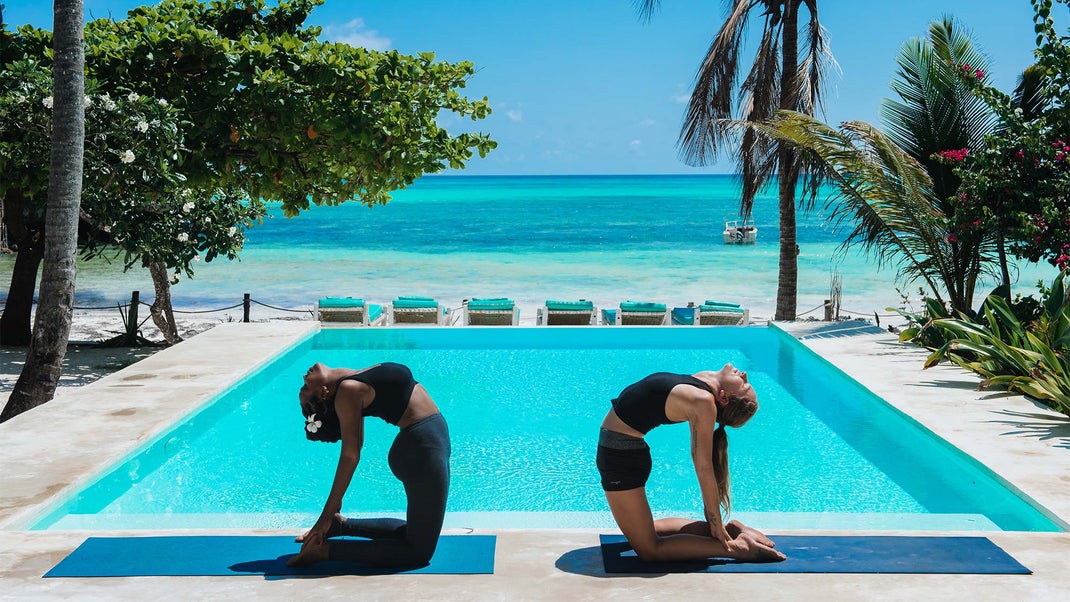Yoga for flexibility and strength for beginners improves overall physical and mental well-being. Achieving flexibility and strength through yoga is beneficial for beginners looking to enhance their physical health and mental wellness.
Incorporating yoga into a fitness routine can lead to improved muscle tone, increased flexibility, and reduced stress. Regardless of your age or fitness level, yoga offers a gentle yet effective way to build strength and improve flexibility.
Beginner-friendly poses can help individuals gradually progress towards more advanced postures, promoting a sense of accomplishment and self-improvement.
As a result, practicing yoga can contribute to a healthier lifestyle and enhanced overall well-being for beginners seeking to improve their flexibility and strength.
Understanding Yoga
Explore the benefits of yoga for beginners, focusing on enhancing both flexibility and strength. As you delve into the practice, you’ll discover how yoga promotes physical wellness while encouraging mental clarity and stress reduction. With dedicated effort, beginners can gradually build a foundation for a rewarding and transformative yoga journey.
“` In today’s modern world, where stress and sedentary lifestyle are prevalent, yoga has emerged as a holistic practice that offers numerous physical and mental benefits. Understanding the essence of yoga is crucial for beginners who seek to embark on a journey of flexibility and strength. By exploring the origins and principles of yoga, individuals can gain a deeper appreciation for this ancient practice and its potential for transformation.
Origins Of Yoga
The roots of yoga can be traced back to ancient India, where it was developed as a means to achieve harmony between the mind, body, and spirit. Yoga stems from the Sanskrit word “yuj,” which means union, signifying the unification of the individual consciousness with the universal consciousness. Over time, various forms and styles of yoga have evolved, each emphasizing different aspects of well-being and self-realization.
Principles Of Yoga
Yoga embodies a set of fundamental principles that form the core of its practice. The principles of yoga encompass asanas (physical postures), pranayama (breath control), meditation, and ethical guidelines. By integrating these principles into their daily routine, beginners can cultivate self-awareness, resilience, and balance, laying the foundation for enhanced flexibility and strength. Through a profound comprehension of the origins and principles of yoga, beginners can lay a solid groundwork for their practice. This understanding can serve as a guiding light, unlocking the transformative potential of yoga for physical and mental well-being. “`

Credit: m.youtube.com
Getting Started With Yoga
Yoga is a transformative practice that offers a multitude of physical and mental benefits. Whether you’re looking to improve your flexibility, build strength, or simply de-stress, yoga offers a practice suitable for everyone. If you’re new to yoga, getting started can be a bit overwhelming, but with the right guidance, you can embark on a fulfilling journey toward better health and wellbeing.
Choosing The Right Yoga Style
When starting your yoga journey, it’s essential to explore various yoga styles to find one that suits your goals and preferences. Some popular options for beginners include Hatha, Vinyasa, and Yin yoga. Hatha yoga focuses on basic postures and is great for beginners looking to build a solid foundation. Vinyasa yoga offers dynamic, flowing sequences that combine movement and breath, ideal for those seeking a more energetic practice. On the other hand, Yin yoga involves longer holds to target deep connective tissues, providing a gentle yet intense stretch.
Essential Yoga Equipment
- Yoga Mat: A non-slip, cushioned mat provides stability and comfort during your practice.
- Yoga Blocks: These props assist in maintaining proper alignment and support for various poses.
- Yoga Strap: Ideal for beginners to extend their reach and improve flexibility in challenging poses.
- Comfortable Clothing: Wear breathable, flexible attire that allows for ease of movement.
- Water Bottle: Staying hydrated is crucial, especially during vigorous yoga sessions.
Yoga Poses For Flexibility
Enhance strength and flexibility through beginner-friendly yoga poses targeting various muscle groups. These poses, such as Downward-Facing Dog and Warrior I, improve range of motion and build a foundation for a balanced yoga practice. Embrace the journey towards increased flexibility and strength with these foundational yoga poses.
Yoga Poses for Flexibility If you’re a beginner looking to improve your flexibility through yoga, you’ve come to the right place. Yoga not only helps to increase your flexibility but also builds strength and improves balance. In this section, we will explore three essential yoga poses for flexibility: Forward Fold, Bridge Pose, and Standing Forward Bend. These poses are perfect for beginners and can be easily incorporated into your daily yoga practice. Let’s dive in and discover how these yoga poses can enhance your flexibility journey.
Forward Fold
Forward fold, also known as Uttanasana, is a simple yet effective yoga pose that targets various parts of the body, including the hamstrings, calves, and lower back. To perform this pose, follow these steps:
- Start by standing tall with your feet hip-width apart.
- Slowly bend forward from your hips, keeping your spine straight.
- Allow your hands to hang towards the ground, either reaching for your toes or resting on the blocks.
- Keep your knees slightly bent if you experience tightness in the hamstring area.
- Stay in this position for a few breaths, allowing your body to relax and gently stretch.
Forward fold promotes a sense of calmness and helps to relieve tension in the neck, shoulders, and back. Regular practice of this pose will gradually increase your flexibility and improve your overall posture.
Bridge Pose
The bridge pose, or Setu Bandha Sarvangasana, is a fantastic yoga pose for strengthening the glutes, hamstrings, and lower back while simultaneously stretching the chest and shoulders. Here’s how you can practice this pose:
- Lie flat on your back with your knees bent and feet hip-width apart, flat on the ground.
- Place your arms alongside your body, palms facing down.
- Press your feet into the ground as you lift your hips off the mat.
- Keep your thighs parallel and engage your glutes as you raise your hips higher.
- Optional: Clasp your hands together beneath your pelvis, interlacing your fingers.
- Hold this pose for a few breaths, feeling the stretch in your chest, shoulders, and hip flexors.
Bridge pose helps to strengthen the core and back muscles while opening up the chest and shoulders. As you consistently practice this pose, you will notice improved flexibility and enhanced mobility in your spine.
Standing Forward Bend
The standing forward bend, also referred to as Uttanasana, is a beginner-friendly pose that primarily targets the hamstrings, calves, and lower back. Additionally, it helps to increase blood flow to the brain, promoting relaxation and reducing stress. Follow these simple steps to practice the standing forward bend:
- Start by standing tall with your feet together.
- Take a deep breath in, and as you exhale, fold forward from your hips.
- Allow your hands to hang towards the ground or find a comfortable position on your shins or blocks.
- Keep a slight bend in your knees if needed, focusing on elongating your spine.
- Relax your neck and let your head hang gently, releasing any tension you may be holding.
- Take a few deep breaths in this pose, feeling the lengthening and stretch in your hamstrings.
Standing forward bend helps to improve posture, relieve stress, and increase flexibility in the hamstrings and lower back. Practice this pose regularly to make noticeable progress in your flexibility journey. These three yoga poses for flexibility are excellent starting points for beginners. Remember to listen to your body and modify the poses as needed. With consistent practice, patience, and proper alignment, you’ll soon begin to experience the wonderful benefits of increased flexibility and strength through yoga. Happy stretching!

Credit: www.amazon.com
Yoga Poses For Strength
Discover beginner-friendly yoga poses that focus on improving flexibility and building strength. From the powerful warrior pose to the energizing tree pose, this guide will help you deepen your practice and enhance your overall physical fitness.
html Yoga Poses for Strength Plank Pose The Plank Pose is a foundational yoga pose that targets the core and works the muscles in your arms, shoulders, and legs. To perform this pose, start by getting into a push-up position with your hands directly under your shoulders and your body in a straight line. Engage your core muscles and hold this pose for a few seconds or as long as you can.
The Plank Pose not only strengthens your muscles but also improves your posture and balance. Warrior II Pose The Warrior II Pose is a powerful yoga pose that targets your quadriceps, hamstrings, and glutes. To get into this pose, start by stepping your feet wide apart, with your right foot pointing forward and your left foot turned slightly inward.
Bend your right knee and extend your arms out to the sides, parallel to the floor. Keep your gaze focused over your right fingertips and hold this pose for a few breaths. The Warrior II Pose builds strength in your lower body and improves your stability and concentration.
Boat Pose The Boat Pose is an intense yoga pose that targets your abs, hip flexors, and lower back. To perform this pose, start by sitting on the mat with your knees bent and your feet flat on the floor. Lean back slightly and lift your feet off the ground, balancing on your sitting bones.
Extend your legs in front of you and reach your arms forward, parallel to the floor. Keep your core engaged and hold this pose for a few breaths. The Boat Pose not only strengthens your core muscles but also improves your digestion and stimulates your kidneys and intestines.
Incorporating these yoga poses for strength into your practice can help you build a strong and resilient body. Whether you’re a beginner or an experienced yogi, these poses are accessible and can be modified to suit your level of flexibility and strength.
Practice them regularly and you’ll soon notice an improvement in your overall strength and endurance. So roll out your mat, get into these poses, and embrace your inner strength!
Combining Flexibility And Strength
Combining flexibility and strength is a key aspect of yoga practice for beginners. Yoga not only helps in enhancing flexibility but also builds strength in various muscle groups. This combination of flexibility and strength contributes to a balanced and well-rounded practice. In this blog post, we will explore two popular styles of yoga that can aid in achieving this balance: Flow Yoga and Power Yoga.
Flow Yoga
Flow Yoga, also known as Vinyasa Yoga, is a dynamic and flowing style that synchronizes movement with breath. It involves smoothly transitioning from one pose to another, creating a seamless “flow” of poses. Flow Yoga is an excellent choice for beginners as it focuses on breath awareness, strength building, and increasing flexibility.
Through the continuous and fluid movements in Flow Yoga, beginners can improve their flexibility while simultaneously building strength. The repetitive nature of flowing through sequences challenges various muscle groups, leading to increased overall body strength. Additionally, the incorporation of balance poses and deep stretches allows for enhanced flexibility in muscles, tendons, and ligaments.
Power Yoga
Power Yoga, on the other hand, is a vigorous and challenging style that focuses primarily on building strength and endurance. It is a perfect choice for beginners looking to develop both flexibility and strength in a dynamic and energetic way.
In Power Yoga, practitioners engage in a series of continuous and intense poses, often performed at a faster pace. This style incorporates elements from various yoga traditions, including Ashtanga and Vinyasa Yoga, to create a physically demanding practice. By holding challenging poses and moving through sequences with control, beginners can enhance their muscular strength, particularly in the core, arms, and legs.
Aside from the muscular strength gained in Power Yoga, increased flexibility is also obtained. The practice includes deep stretches and poses that target tight muscles, gradually improving range of motion and flexibility. This combination of strength and flexibility in Power Yoga helps beginners develop an overall balanced and resilient body.
Whether you choose to practice Flow Yoga or Power Yoga, remember that consistency is key. Regularly incorporating these styles into your practice will allow you to develop both flexibility and strength progressively. So, don’t be afraid to explore and find the right balance between the dynamic movements of Flow Yoga and the strength-focused practice of Power Yoga.

Credit: breath-of-fire.com
Mental Benefits Of Yoga
When it comes to the mental benefits of yoga, the practice goes far beyond just physical strength and flexibility. Yoga has long been recognized for its ability to enhance mental well-being, providing a sense of calm and clarity to practitioners. In this article, we will explore two key mental benefits of yoga for beginners: reducing stress and anxiety, and improving concentration.
Reducing Stress And Anxiety
Yoga offers a powerful antidote to the fast-paced, stress-filled lifestyles many of us lead. By incorporating breathwork, mindful movement, and meditation, yoga helps to reduce stress and anxiety levels. The controlled breathing techniques used in yoga activate the parasympathetic nervous system, triggering a relaxation response that counteracts the effects of chronic stress.
Practicing yoga regularly can also help to lower cortisol, the stress hormone, in the body. This can have a profound impact on overall well-being, as high cortisol levels have been linked to increased anxiety, depression, and sleep disturbances.
Furthermore, yoga teaches individuals to be more present in the moment, cultivating a greater awareness of thoughts and emotions. By tuning into the body and breath during the practice, yoga promotes mindfulness and helps individuals let go of worries and distractions.
Improving Concentration
In our increasingly digital age, it can be challenging to maintain focus and concentration. Yoga offers a sanctuary from our fast-paced, constantly connected world, allowing us to cultivate a calm and focused mind. Through the practice of yoga, individuals can improve concentration and enhance the ability to stay present.
One of the ways yoga accomplishes this is by encouraging individuals to connect their body and breath. This mind-body integration promotes a deeper level of concentration, as practitioners learn to focus their attention on the sensations within their body. This heightened awareness carries over into daily life, enhancing the ability to concentrate on tasks and remain present in the moment.
Additionally, yoga often incorporates meditation and mindfulness practices, which have been shown to improve attention span and cognitive function. Research has found that regular yoga practice can increase gray matter density in areas of the brain associated with memory, attention, and learning.
In conclusion, the mental benefits of yoga for beginners are vast and powerful. By reducing stress and anxiety, and improving concentration, yoga provides individuals with a holistic approach to mental well-being. Whether you are a beginner or an experienced practitioner, integrating yoga into your routine can have a profound impact on your mental health and overall quality of life.
Frequently Asked Questions Of Yoga For Flexibility And Strength For Beginners
Which Yoga Is Best For Strength And Flexibility?
Power yoga is the best choice for building strength and flexibility. Its dynamic movements and intense poses target muscles and increase flexibility.
Does Yoga Improve Flexibility For Beginners?
Yes, yoga improves flexibility for beginners. Regular practice helps stretch muscles and increase joint range of motion.
What Type Of Yoga Should A Beginner Start With?
A beginner should start with Hatha yoga, as it focuses on basic poses and breathing techniques.
What Is The Best Yoga To Learn For Beginners?
The best yoga for beginners is Hatha yoga. It focuses on basic poses and breath control to build a strong foundation. Hatha is gentle and customizable for all levels, making it perfect for those new to yoga. Its slow pace allows for learning and mastering techniques effectively.
Conclusion
To sum it up, yoga is a powerful practice that can enhance both flexibility and strength, making it perfect for beginners. By incorporating simple yet effective poses and sequences into your routine, you can gradually build your physical capabilities while enjoying the calming benefits for your mind and body.
Whether you’re looking to improve your overall fitness or alleviate stress, yoga provides a holistic approach that can leave you feeling more balanced and empowered. So, roll out your mat and embark on this transformative journey today!



